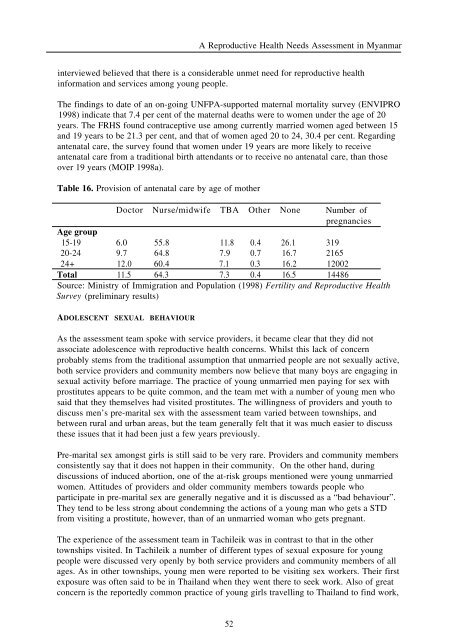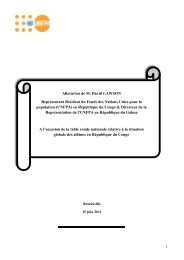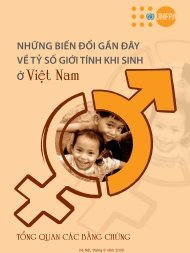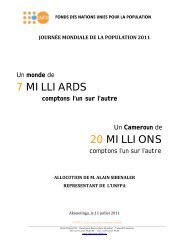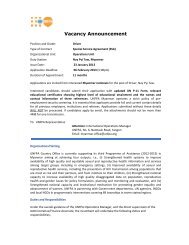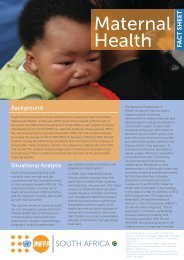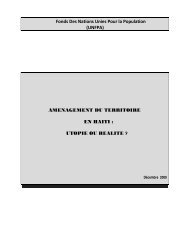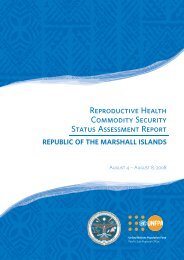A reproductive health needs assessment in Myanmar
A reproductive health needs assessment in Myanmar
A reproductive health needs assessment in Myanmar
Create successful ePaper yourself
Turn your PDF publications into a flip-book with our unique Google optimized e-Paper software.
A Reproductive Health Needs Assessment <strong>in</strong> <strong>Myanmar</strong><br />
<strong>in</strong>terviewed believed that there is a considerable unmet need for <strong>reproductive</strong> <strong>health</strong><br />
<strong>in</strong>formation and services among young people.<br />
The f<strong>in</strong>d<strong>in</strong>gs to date of an on-go<strong>in</strong>g UNFPA-supported maternal mortality survey (ENVIPRO<br />
1998) <strong>in</strong>dicate that 7.4 per cent of the maternal deaths were to women under the age of 20<br />
years. The FRHS found contraceptive use among currently married women aged between 15<br />
and 19 years to be 21.3 per cent, and that of women aged 20 to 24, 30.4 per cent. Regard<strong>in</strong>g<br />
antenatal care, the survey found that women under 19 years are more likely to receive<br />
antenatal care from a traditional birth attendants or to receive no antenatal care, than those<br />
over 19 years (MOIP 1998a).<br />
Table 16. Provision of antenatal care by age of mother<br />
Doctor Nurse/midwife TBA Other None Number of<br />
pregnancies<br />
Age group<br />
15-19 6.0 55.8 11.8 0.4 26.1 319<br />
20-24 9.7 64.8 7.9 0.7 16.7 2165<br />
24+ 12.0 60.4 7.1 0.3 16.2 12002<br />
Total 11.5 64.3 7.3 0.4 16.5 14486<br />
Source: M<strong>in</strong>istry of Immigration and Population (1998) Fertility and Reproductive Health<br />
Survey (prelim<strong>in</strong>ary results)<br />
ADOLESCENT SEXUAL BEHAVIOUR<br />
As the <strong>assessment</strong> team spoke with service providers, it became clear that they did not<br />
associate adolescence with <strong>reproductive</strong> <strong>health</strong> concerns. Whilst this lack of concern<br />
probably stems from the traditional assumption that unmarried people are not sexually active,<br />
both service providers and community members now believe that many boys are engag<strong>in</strong>g <strong>in</strong><br />
sexual activity before marriage. The practice of young unmarried men pay<strong>in</strong>g for sex with<br />
prostitutes appears to be quite common, and the team met with a number of young men who<br />
said that they themselves had visited prostitutes. The will<strong>in</strong>gness of providers and youth to<br />
discuss men’s pre-marital sex with the <strong>assessment</strong> team varied between townships, and<br />
between rural and urban areas, but the team generally felt that it was much easier to discuss<br />
these issues that it had been just a few years previously.<br />
Pre-marital sex amongst girls is still said to be very rare. Providers and community members<br />
consistently say that it does not happen <strong>in</strong> their community. On the other hand, dur<strong>in</strong>g<br />
discussions of <strong>in</strong>duced abortion, one of the at-risk groups mentioned were young unmarried<br />
women. Attitudes of providers and older community members towards people who<br />
participate <strong>in</strong> pre-marital sex are generally negative and it is discussed as a “bad behaviour”.<br />
They tend to be less strong about condemn<strong>in</strong>g the actions of a young man who gets a STD<br />
from visit<strong>in</strong>g a prostitute, however, than of an unmarried woman who gets pregnant.<br />
The experience of the <strong>assessment</strong> team <strong>in</strong> Tachileik was <strong>in</strong> contrast to that <strong>in</strong> the other<br />
townships visited. In Tachileik a number of different types of sexual exposure for young<br />
people were discussed very openly by both service providers and community members of all<br />
ages. As <strong>in</strong> other townships, young men were reported to be visit<strong>in</strong>g sex workers. Their first<br />
exposure was often said to be <strong>in</strong> Thailand when they went there to seek work. Also of great<br />
concern is the reportedly common practice of young girls travell<strong>in</strong>g to Thailand to f<strong>in</strong>d work,<br />
52


